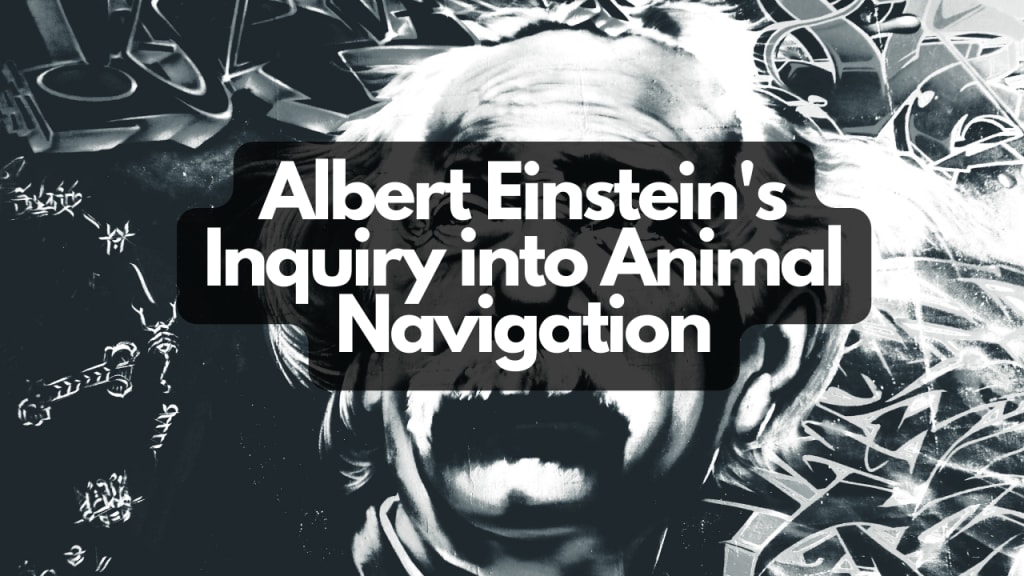Albert Einstein's Inquiry into Animal Navigation
Unveiling the Enigma of Earth's Magnetic Field

In the world of science, it was 1949 when Albert Einstein, already celebrated for his groundbreaking theories, received a letter from an English engineer. Though the original letter has been lost to history, Einstein's reply, recently discovered, offers a fascinating glimpse into his musings on animal navigation. Over seventy years ago, Einstein contemplated the possibility that studying the behavior of migratory birds and carrier pigeons might unveil previously unknown physical processes. At the time, biology and physics were only beginning to unravel the mysteries of animal behavior. This article explores the extraordinary sensory capabilities of animals, from bats' echolocation to bees' magnetic orientation, shedding light on the scientific advancements that followed Einstein's ponderings.
Bats: Masters of Echolocation
Traditionally associated with blindness, bats possess remarkable navigational abilities through echolocation. Rather than relying on sharp, colorful vision like humans, bats use sound waves to navigate their surroundings. By emitting high-frequency sounds through their mouth or nose, bats interpret the echoes that bounce back from objects in their environment. This sophisticated form of echolocation allows bats to create an accurate 3D image of their surroundings, enabling them to detect objects as small as a human hair. Although the term "echolocation" was coined in the 1940s, it was Einstein's contemporaneous understanding of the breakthrough that may have alluded to this phenomenon.
Bees: Navigating by Magnetic Field
Einstein's letter also mentioned the extraordinary sensory perception exhibited by bees, anticipating that their behavior could provide insights into previously unexplored realms. Unlike bats, bees do not rely on echolocation. Instead, they possess the ability to detect and navigate using the Earth's magnetic field. Earth's magnetic field, generated within its interior, extends into space, shielding us from the sun's radiation. Bees, equipped with tiny receptors inside their abdomens, potentially containing iron granules, act as internal compasses. This remarkable sense of direction enables bees to navigate with precision, making extensive foraging journeys and always returning to their hives. Combined with their utilization of sunlight, bees showcase an intricate understanding of their environment.
Dogs: Canine Compasses
Another example of remarkable animal navigation is demonstrated by dogs. While historically believed to rely solely on their sense of smell, research has revealed that dogs possess additional navigational capabilities. Experiments have shown that dogs do not simply retrace their steps when finding their way home. Instead, they use a different path, indicating the potential use of the Earth's magnetic field for navigation. Studies suggest that dogs may have an innate sensitivity to the magnetic field, allowing them to orient themselves even in unfamiliar environments. These canine navigational skills were highlighted by the remarkable story of Pablo, a hunting terrier who embarked on an arduous journey of more than 200 miles to reunite with his owners.
Fish: Magnetic Navigators
Among the most adept navigators in the animal kingdom are fish, particularly salmon. These remarkable creatures embark on long journeys, often covering distances longer than cross-country roads. Upon reaching maturity, salmon return to their natal rivers to breed. Researchers have discovered small deposits of a magnetic mineral in the sinuses of salmon, suggesting the presence of magnetic receptors. This finding implies that fish, including salmon, possess an innate ability to sense the Earth's magnetic field. Combined with their extraordinary sense of smell, which is a thousand times more sensitive than that of dogs, fish exemplify the profound interplay between natural phenomena and animal navigation.
Birds: Migratory Marvels
Einstein's letter also alluded to the behavior of migratory birds, highlighting their remarkable navigation skills. Researchers have proposed several theories to explain how birds navigate during their long migratory journeys. Some suggest that birds utilize the sun and moon as celestial compasses, while others propose the use of landmarks for orientation. However, a prevalent theory suggests that birds possess an ability to perceive and utilize the Earth's magnetic field for navigation. Scientists have discovered small magnetic particles within the beaks of pigeons, leading to speculations that these particles aid in their orientation. By harnessing the Earth's magnetic field, birds accomplish astounding feats of navigation during their migratory journeys.
Albert Einstein's brief yet intriguing reply to an English engineer's letter on animal behavior offers valuable insights into the mysterious world of animal navigation. From bats' echolocation to bees' magnetic orientation, dogs' innate compasses, fish's sensorial capabilities, and birds' extraordinary migratory journeys, the animal kingdom demonstrates an array of fascinating navigation techniques. Einstein's speculation about the untapped physical processes governing animal behavior foreshadowed the subsequent scientific advancements in understanding the interconnectedness of biology and physics. As we continue to unravel the mysteries of animal navigation, we gain deeper insights into the remarkable mechanisms that allow different species to navigate and thrive in our complex world.
About the Creator
Mahamud Hayet Arpon
I am a versatile and talented writer with a passion for storytelling. Born with a vivid imagination and a love for words, I embarked on a literary journey that has shaped their identity as a writer.






Comments
There are no comments for this story
Be the first to respond and start the conversation.